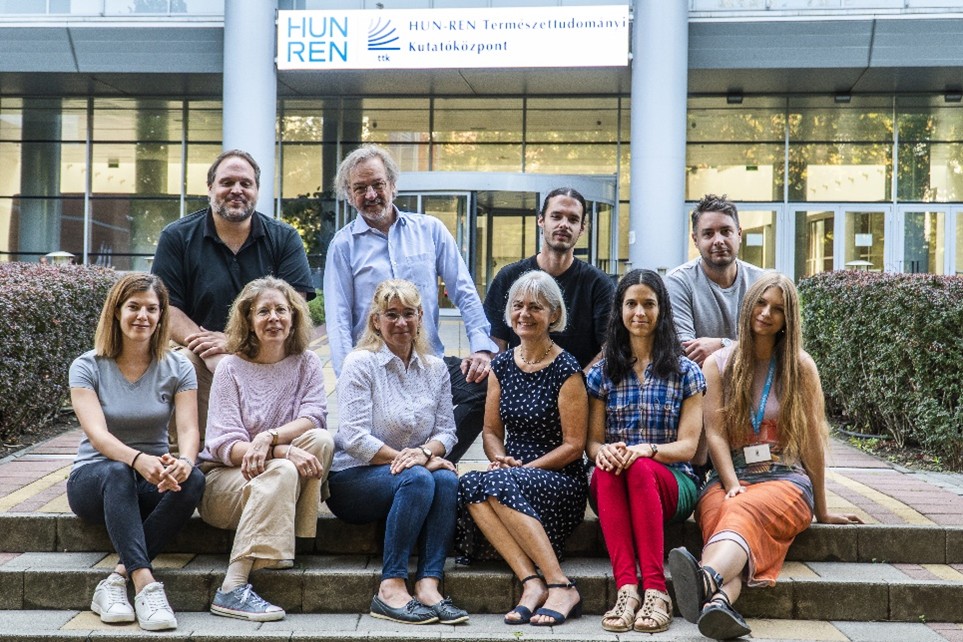General overview, history of the group
In the 2024 Research Grant Hungary program, Professor András Nagy received five-year funding for his project titled Anti-tumor vaccine 2.0: Immunomodulation with “repackaged” cancer cells. To implement the project, a new research group was established, with additional researchers joining from existing groups of the Institute of Molecular Life Sciences.
Research Area
Cancer cells are able to evade immune system attacks through various mechanisms; therefore, the goal of anti-cancer immunotherapies is to overcome these escape strategies. Currently, there are two main approaches: passive immunization, in which external immune cells or antibodies are introduced into the body (e.g., CAR-T, NK, and macrophage therapy), and active immunization, which stimulates the patient’s own immune response (e.g., cancer vaccines, immune checkpoint inhibitors, oncolytic viruses).
Our research group and project apply a novel approach: we aim to develop a personalized, tumor-cell-based active immunization therapy.
The resulting modified tumor cells, expected to activate the immune system, should retain the desired tumor-specific properties. After in vitro expansion, they can be reintroduced into the patient to elicit an effective immune response and provide long-term protection against tumor recurrence.
We investigate the immunogenicity of modified versus original tumor cells in vitro and in vivo. Their therapeutic efficacy will be tested in mouse cancer models. We will also develop models for human application, using knowledge from these experiments.

Lab members
András Nagy, principal investigator
András Füredi, deputy PI
Ágota Apáti, senior researcher
Katalin Monostory, senior researcher
Gergely Szakács, senior researcher
Eszter Bajtai, junior researcher
Sámuel Balázs, PhD student
Ferenc Fekete, junior researcher
Kiara Gitta Farkas, PhD student
Beáta Haraszti, technician
Hegedűs Károly, PhD student
Kotnyek Orsolya, project manager
Lovrics Anna, junior researcher
Mohos Krisztina, lab manager
Collaborations
Lunenfeld-Tanenbaum Research Institute, Mount Sinai Hospital Toronto
Hong Kong University
Semmelweis University
Key publications
Guo L, Duchesneau P, Jong ED, Sawula E, Waddell TK, Nagy A. GDF11-secreting cell transplant efficiently ameliorates age-related pulmonary fibrosis. Molec Ther. 2025. July 16; S1525-0016(25)00539-8. doi: 10.1016/j.ymthe.2025.07.00; epub ahead of print. PMID: 40676836
Bajtai E, Kiss C, Bakos É, Langó T, Lovrics A, Schád É, Tisza V, Hegedűs K, Fürjes P, Szabó Z, Tusnády GE, Szakács G, Tantos Á, Spisák S, Tóvári J, Füredi A. Therapy-induced senescence is a transient drug resistance mechanism in breast cancer. Mol Cancer. 2025 May 1;24(1):128. doi: 10.1186/s12943-025-02310-0. PMID: 40312750; PMCID: PMC12044945.
Pavan C, Davidson KC, Payne N, Frausin S, Hung CPJ, Moriarty N, Berrocal-Rubio MA, Alahi Z, Quattrocchi AT, Abu-Bonsrah KD, Wang L:, Clow W, Yang H, Pellegrini M, Wells CA, Thompson LH, Nagy A, Parish C. A cloaked human stem-cell-derived neural graft capable of functional integration and immune evasion in rodent models. Cell Stem Cell 2025. May 1; 32, 1-17; https://doi.org/10.1016/j.stem.2025.03.008. PMID: 40209717
Hotta A, Schrepfer S, Nagy A. Genetically engineered hypoimmunogenic cell therapy. Nat Rev Bioeng 2024 July 29. 2: 960-979; doi.org/10.1038/s44222-024-00219-9.
Harding J, Vintersten-Nagy K, Yang H, Tang JK, Shutova M, Jong ED, Lee JH, Massumi M, Oussenko T, Izadifar Z, Zhang P, Rogers IM, Wheeler MB, Lye SJ, Sung HK, Li CJ, Izadifar M, Nagy A. Immune-privileged tissues formed from immunologically cloaked mouse embryonic stem cells survive long term in allogeneic hosts. Nat Biomed Eng 2024. April; 8(4): 427-442. doi: 10.1038/s41551-023-01133-y. PMID: 37996616
Sawula E, Miersch S, Jong ED, Li CJ, Chou FY, Tang JK, Saberianfar R, Harding J, Sidhu SS, Nagy A. Cell-based passive immunization for long-term protection against SARS-CoV-2 infection. Stem Cell Res Ther 2023. Nov 6. 14(1): 318. doi: 10.1186/s13287-023-03556-5. PMID: 37932852
Izadifar M, Beresz T, Li B, Tang JKKY, Foldes G, Apati A, Nagy A. Speckle-tracking strain analysis for mapping spatiotemporal contractility of induced-Pluripotent Stem Cell (iPSC)-derived cardiomyocytes. Current Protocols in Pharmacology 2023, Sept 25; 3(9):e889. doi.org/10.1002/cpz1.889. PMID: 3774746
de Luzy IR, Law KC, Moriarty N, Hunt CP, Durnall JC, Thompson LH, Nagy A, Parish CL. Human strem cells harboring a suicide gene improve the safety and standardisation of neural transplants in Parkinsonian rats. Nat Commun 2021, May 27; 12: 3275. PMID: 34045451
Izadifar M, Berecz T, Apati A, Nagy A. An optical-flow-based method to quantify dynamic behavior of human pluripotent stem cell-derived cardiomyocytes in disease modeling platforms. Methods Mol Biol 2021 May 13. (epub ahead of print) doi: 10.1007/7651_2021_382. PMID: 33982275.
Harding J, Vinterstein-Nagy K, Nagy A. (2020) Universal Stem Cells: making the unsafe safe. Cell Stem Cell. 2020. Aug 6, 27(2): 198-9. Letter re: Gonzalez BJ et al, (Cell Stem Cell 26:307-308, March 5, 2020). PMID: 32763181
Lanza R, Russell D, Nagy A. (2019) Engineering universal cells that evade immune detection. Nature Reviews | Immunology. 2019. Aug 15. doi: 10.1038/s41577-019-0200-1 [Epub head of print]. PMID: 31417198
Liang Q, Monetti C, Shutova MV, Neely EJ, Hacibekiroglu S, Yang H, Kim C, Zhang P, Li C, Nagy K, Mileikovsky M, Gyongy I, Sung HK, Nagy A. (2018) Linking a cell-division gene and a suicide gene to define and improve cell therapy safety. Nature. 2018. Nov 21; 563(7733): 701-704 PMID: 30429614
Project no. RGH-151536 has been implemented with the support provided by the Ministry of Culture and Innovation of Hungary from the National Research, Development and Innovation Fund, financed under the RGH_24 funding scheme.



